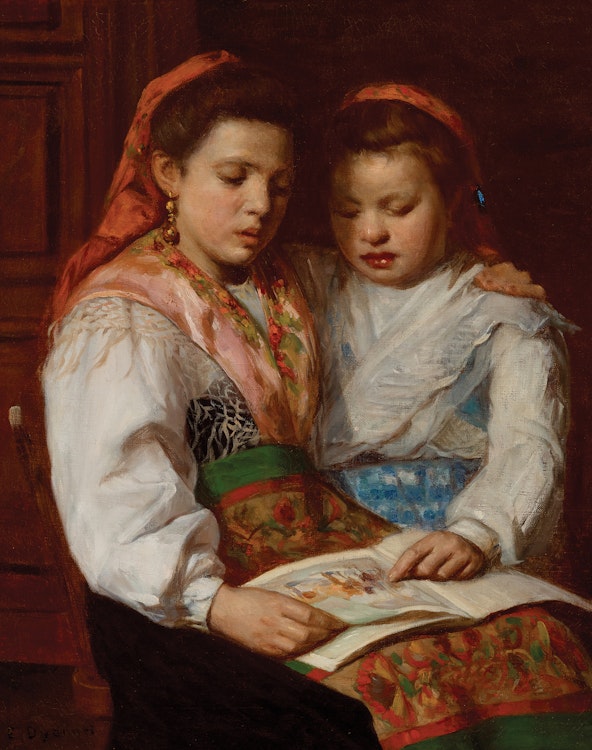The Picture Book, 1909 by Edmond Dyonnet

Edmond Dyonnet
The Picture Book, 1909
oil on canvas
signed lower left
25 x 20 ins ( 63.5 x 50.8 cms )
Auction Estimate: $3,000.00 - $5,000.00
Price Realized $6,000.00
Sale date: December 6th 2023
M. Brillant, Rimouski, Quebec
Estate of Mme Madeleine Brillant Humbert, Montreal/Monte Carlo
Galerie Walter Klinkhoff, Montreal
Acquired by the present Private Collection, October 2013
“Thirtieth Annual Exhibition”, Royal Canadian Academy of Arts, Ottawa, 6-21 May 1909, no. 44
“Thirty-First Exhibition, Royal Canadian Academy of Arts”, Art Gallery Public Library, Hamilton, 25 November 1909, no. 44
“Canadian Art: A Child's World, Annual Exhibition”, Galerie Eric Klinkhoff, Montreal, 28 October‒11 November 2017, no. 25
“Our Children: Reflections of Childhood in Historical Canadian Art,” Varley Art Gallery, Markham, 13 April 2019‒23 June 2019
Dyonnet was best known as a landscape painter and portraitist, especially among the wealthy citizens of Montreal. Judges, doctors, and community leaders all commissioned their portraits. His inspirations were seventeenth century painters Nicolas Poussin and Claude Gellée (also known under the name Le Lorrain). Dyonnet maintained an academic style throughout his career; he was never drawn to Impressionism. This portrait of two girls reading a book together has a very strong attention to detail, particularly in the fabrics, colours and patterns of their dress.
Share this item with your friends
Edmond Dyonnet
(1859 - 1954) RCA
Born at Crest, France, his family name was originally Guyonnet de Pivat but through an error in registration, following the French Revolution, the name was recorded as Dyonnet. In 1868 he moved with his family to Turin, Italy, where he attended school until 1873, when his father’s business took them back to Crest. He came to Montreal, Canada, in 1875, when his family settled there. He attended the School of Arts and Crafts where he copied lithographs and did studies from the cast. Seeking more advanced instruction he went to Italy where he studied under Professor Gastaldi. Working seven days a week to get the most out of his classes he made a very keen student.
On his holidays Dyonnet painted in the Alps. He also travelled to Genoa, Milan (visited the Duomo where 6,000 statues are located), Pavia, Verona (saw the Roman Amphitheatre), Venice (visited the Palazzo Ducale, The Church of San Marco, museums and other churches where the works of Titian, Paolo Veronese, Tintoretto and other great artists were to be seen), Bologna, Florence (where he viewed the works of Andrea del Sarton), Pisa, Rome, Naples (where he studied under Professor Marinelli). He also studied at the Scoula Libera, and the Académie de France at the villa Medicis.
After four years in Italy he returned home to Montreal. He opened a studio and did his first commission, an allegorical landscape, a work for which he was never paid. In 1916 he moved into a studio which he was to occupy for the next 33 years. He received better remuneration for portraits as he became known for this work. In 1891 he was appointed drawing master at the Council of Arts where he introduced better procedures in the instruction of its pupils. Dyonnet played an important part in the development of Zotique Fabien, one of his pupils who became the successful painter Henri Fabien of Ottawa.
He resigned from the Council of Arts on 1922 to accept a new post of Professor of Drawing at the Ecole des Beaux-Arts, Montreal. He had been instrumental in the founding of that school with Suzor-Coté and Alfred Laliberté. William Brymner had been a friend of Dyonnet for a number of years. When Brymner became President of the Academy and Dyonnet its secretary (a post he held for 32 years), their business brought them together almost daily. It was Dyonnet who helped Brymner back to recovery after his stroke, by walking daily with him until he was well enough to continue his painting trips. Dyonnet, Brymner and Maurice Cullen were guests of Horatio Walker who lived on the Island of Orleans where they painted on several occasions. In 1872 Dyonnet’s cousin arrived in Canada. Also a painter, he signed his canvases E. Dyonnet causing minor confusion to some art collectors; he died in Montreal in 1875.
Dyonnet did a number of landscapes but always preferred the human figure in his choice of subject matter. At the age 92 Dyonnet wrote his memoirs which were mimeographed and distributed by Thomas. R. Lee. Dyonnet also collaborated with Hugh G. Jones in the writing of the history of the Royal Canadian Academy. Edmond Dyonnet died in Montreal at the age of 95. He is represented in the National Gallery of Canada, R.C.A. Diploma Collection.
Sources: "A Dictionary of Canadian Artists, Volume I: A-F", compiled by Colin S. MacDonald, Canadian Paperbacks Publishing Ltd, Ottawa, 1977

